#sino sculpture
Explore tagged Tumblr posts
Text

Richard Hudson, "Love Me," 2016,
Polished Mirrored Steel, H: 800 cm,
Donum Estate, Sonoma, California, United States
#art#love#heart#heart-shaped#surreal#sino sculpture#richard hudson#loveme#mirrored#steel#donum#sonoma#california
3 notes
·
View notes
Text
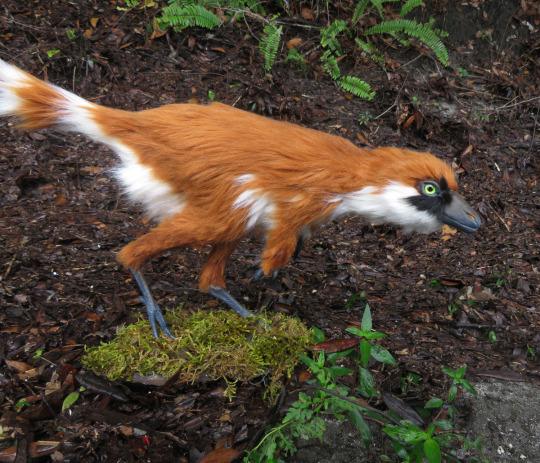
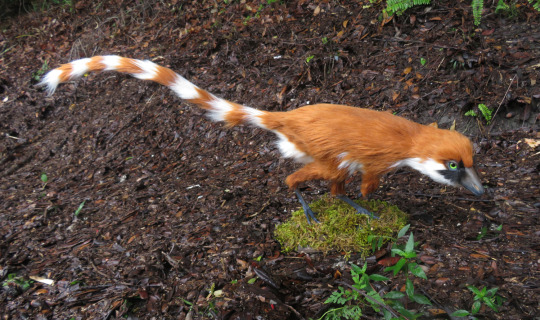




Got 2 little guys for sale, the Sinosauropteryx is $200 and the Jinfengopteryx is $400
#sculpture#for sale#feathered dinosaur#sinosauropteryx#jinfengopteryx#little guys#The Sino is 24 inches long and the Jinfengopteryx is 27 inches from nose to tail feather#but takes up 17 inches of height and 12 inches of width
1K notes
·
View notes
Text
R. Murray Schafer (1933-2021)

Nacido en Sarnia, Canadá, fue compositor, escritor, educador y ambientalista.

El trabajo de Schafer resulta fundamental para concebir la idea de una experiencia de la escucha como parte de un ambiente o “ecología acústica”.
Schafer nos propone que existen sonidos referenciales que tendrían que estar protegidos y catalogados como parte de la flora o la fauna de un ecosistema, ya que el impacto de la presencia humana ha modificado los entornos sonoros del mundo.
Sin embargo, también existen sonidos que forman parte del entorno cultural de una comunidad, ya que representan la experiencia colectiva de un grupo de personas, que comparten un territorio, una historia y un sentido de pertenencia. Los sonidos también hablan de las personas, de su pasado, su presente y su futuro.

El paisaje sonoro (soundscape) es una categoría que integra todos los sonidos que forman parte de un entorno y se conciben tres elementos fundamentales para definirlo, el keynote o tono, que se refiere a los sonidos de fondo y es la base de todo paisaje sonoro. La señal sonora o sound signal integra los sonidos generales del entorno como el ladrido de un perro o la alarma de un reloj, estas señales aportan capas de profundidad y son elementos que permiten dar forma al paisaje; finalmente y quizás el más importante, el soundmark o sonido referencial. Esta marca sonora es considerada como el punto de referencia o hito que le da carácter a un lugar, por ejemplo la letanía que reproducen las camionetas que ofrecen servicios de compra venta de colchones, refrigeradores, estufas y muebles viejos en la Ciudad de México, si bien es probable que este servicio se ofrezca en otros lugares del mundo, el famoso sonsonete publicitario es un acontecimiento endémico de las las calles de la CDMX, un soundmark chilango.

"Sounds Unseen: An exhibition of musical manuscripts and sound sculpture", 1970
Schafer también acuñó el término esquizofonía (schizophonia) en 1969, para aludir a la fisura abierta entre un sonido original y su reproducción en otro tiempo y lugar. Este concepto proviene de la invención de equipos electroacústicos para la transmisión del sonido, lo que significaba que cualquier sonido podía ser grabado y enviado a cualquier parte del mundo. Originalmente, eso no era posible, ya que cada sonido era original y solo podía escucharse una vez. La esquizofonía es la separación de este sonido nativo y su grabación; y el término se centra en los efectos perjudiciales de esto para los individuos y las sociedades en general.
youtube
"Hemos separado el sonido del creador del sonido. Los sonidos han sido arrancados de sus cuencas naturales y se les ha dado una existencia amplificada e independiente. El sonido vocal, por ejemplo, ya no está atado a un agujero en la cabeza, sino que es libre de emitir desde cualquier lugar del paisaje"
#R Murray Schafer#Paisaje Sonoro#Arte Sonoro#LiSE#FADUNAM#Experimentación Sonora#Schizophonia#Esquizofonía#Soundscape#Ecología Acústica
3 notes
·
View notes
Text

Brassai (Gyula Halász,1899-1984) ‘Sculptures involontaires’, in Minotaure N°1, Paris, 1933
Jugando como los surrealistas - Escultura involuntaria
La escultura involuntaria es básicamente una manipulación inconsciente del material. Algunas veces hemos realizado esto en nuestra cotidianidad de manera inconsciente, por ejemplo, cuando estamos aburridos y comenzamos a enrollar un tiquete o desdoblar un clip. La escultura involuntaria es un tipo de escultura que combina la experimentación abierta con la investigación multisensorial.
La idea de esta actividad es manipular una pequeña cantidad de material mientras se “distrae” deliberadamente. Con esta actividad no se espera crear una escultura artística, sino disfrutar el proceso, prestando atención a cómo se siente el material en sus manos y las acciones que se puede realizar con él.
Paso 1
Seleccione su material de preferencia, se recomienda utilizar materiales fácilmente disponibles que requieran un tiempo mínimo de preparación y limpieza, por ejemplo, plastilina, papel o alambre de metal.
Paso 2
Busque un espacio cómodo para jugar con el material en sus manos.
Paso 3
Todos tenemos una tendencia a trabajar intencionadamente, dirigiendo nuestro trabajo hacia un resultado específico. Para contrarrestar esta tendencia, se sugiere colocarse en alguno de los siguientes escenarios mientras se juega con el material:
Sentarse en la oscuridad (o con los ojos cerrados),
Escuchar atentamente música o un audiolibro,
Ver una película o un vídeo.
Paso 4
Una vez concluida la experimentación, fotografíe las piezas creadas, ya sea individualmente, a manera de collage o a manera de ensamblaje.
Paso 5
Anote sus reflexiones y descubrimientos sobre las piezas creadas.
2 notes
·
View notes
Photo
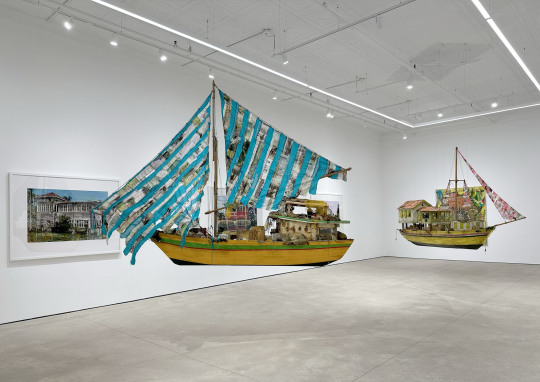
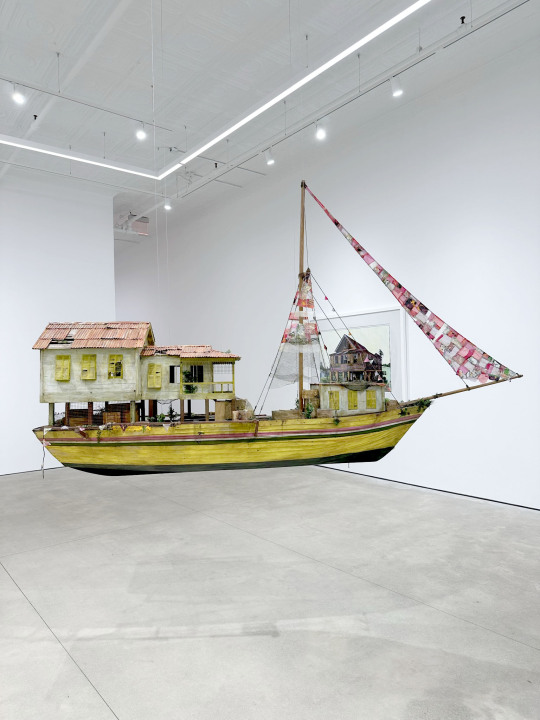
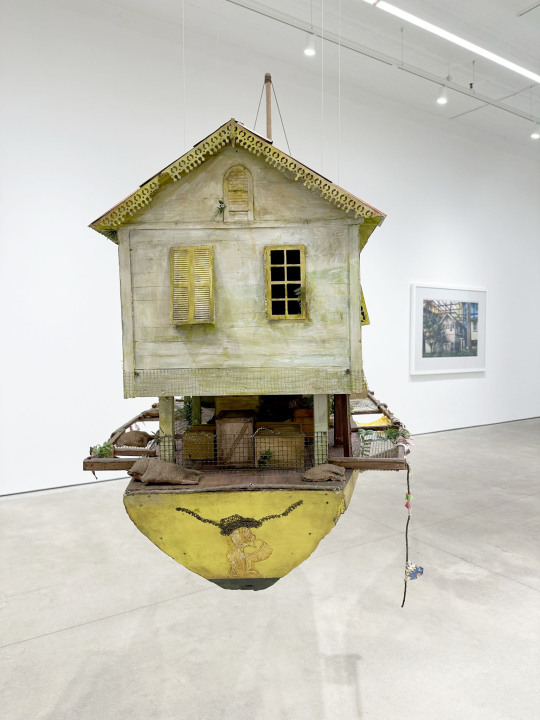
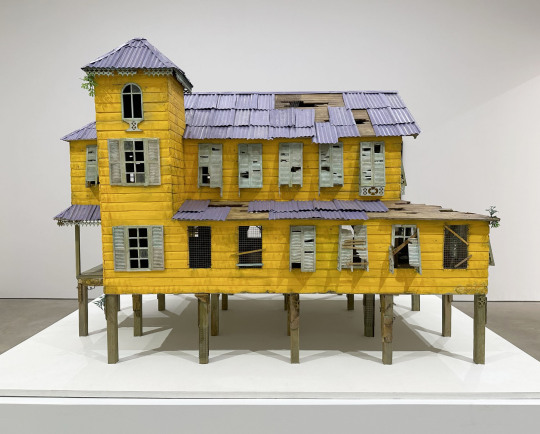

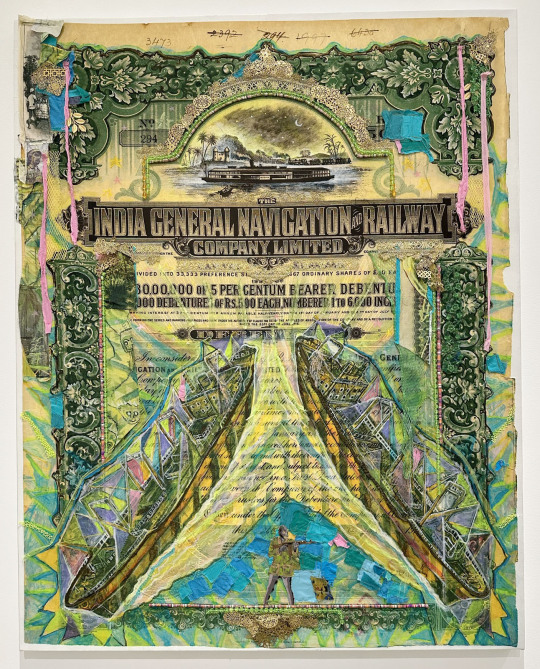


For Hew Locke’s exhibition, Listening to the Land, at P.P.O.W. he has created intricate sculptures and paintings that are fascinating in person.
From the press release-
Locke is known for exploring the languages of colonial and post-colonial power, and the symbols through which different cultures assume and assert identity. Furthering the themes explored in his celebrated commission The Procession at Tate Britain, and his concurrent installation Gilt on the façade of The Metropolitan Museum of Art, this exhibit engages with contemporary and historical inequities while reflecting on the landscape and history of the Caribbean. The exhibition draws its title from a poem by Guyanese political activist and poet Martin Carter which situates itself between two opposing forces of the landscape – sea and forest. Locke’s show features new sculptures and wall works with recurring motifs of stilt-houses, boats, memento mori, and share certificates referencing tensions between the land, the sea, and economic power. Reflecting on these links, Locke notes, “The land was created to generate money for colonial power, now the sea wants it back.”
Translating to ‘land of many waters,’ Guyana and its physical, economic, and political landscape serve as one of the primary sources for Locke’s work. Having spent his childhood in this newly independent nation, the artist witnessed first-hand an era of radical transformation. Now, the country teeters on the precipice of an oil boom and is one of the world’s fastest growing economies. Juxtaposing personal meditations on the climate crisis with political commentary on the history of a globalized world, Locke contemplates the ways in which colonies were exploited to accumulate capital, and observes how Guyana’s economic future lies in the exploitation of its waters. Locke’s new boat sculptures The Relic and The Survivor embody this broad worldview as the two battered wrecks drift through time and history. Evoking the fragmented and diverse legacies of the global diaspora, the boats’ patchwork sails are interspersed with photo transfers of 19th Century cane cutters and banana boat loaders, while their decks are loaded with cargo that could allude to colonial plunder, trade goods or personal belongings.
Based on an abandoned plantation house, Locke’s newest sculpture Jumbie House 2 features layered images that unveil the spirits that haunt this colonial vestige. Presented alongside are a series of painted photographs of dilapidated vernacular architecture across Georgetown and rural Guyana. Constantly under threat of being washed away by storms or rising sea levels, these crumbling structures echo anxieties surrounding climate change and historical erasure. A new series of mixed media wall works, Raw Materials, is derived from antique share certificates and bonds. Locke richly decorates the appliques with acrylic, beads, and patchwork to draw attention to the complex ways in which the past shapes the present. The image of an 1898 Chinese Imperial Gold Loan behind painted Congolese figures connects the global economy at the height of Empire to current Sino-African trade networks. In another work, a painted representation of a Nigerian Ife mask, alongside an image of David Livingstone, is layered on a French-African Mortgage Bond from 1923, connecting exploration and exploitation of African land, to current conversations surrounding the repatriation of artifacts. Taken together, the works in Locke’s Listening to the Land echo William Faulkner’s adage “The past is never dead. It’s not even past.”
This exhibition closes 4/1/23.
The Procession, mentioned above, can now be seen at Baltic Centre for Contemporary Art, in Gateshead, England until June 11th, 2023.
Gilt, also mentioned above, is on view at The Metropolitan Museum of Art until May 30th, 2023.
#hew locke#p.p.o.w#p.p.o.w gallery nyc#nyc art shows#sculpture#art installation#painting#guyana#baltic centre for contemporary art#the met#the metropolitan museum of art#uk art shows#art#art shows#models#photography#england art shows#gateshead#newcastle
15 notes
·
View notes
Photo

“Archaic Forms” Painting and sculpture are very archaic forms. It’s the only thing left in our industrial society where an individual alone can make something with not just his own hands, but brains, imagination, heart maybe. #philipguston Pencils, ink and collage on paper. La pintura y la escultura son tecnicas muy arcaicas. Es lo único que queda en nuestra sociedad industrial donde un individuo solo puede hacer algo no solo con sus propias manos, sino también con el cerebro, la imaginación y quizás el corazón. #philipguston Lápices, tinta y collage sobre papel. #archaic#oscarrey#oscarangelreysoto#oscaratelier#quoteoftheday#fineart#artistlife#contemporaryart#painting#contemporary#artcollector#artaddict#Malerei#zeichnungen#pintura (hier: Berlin, Germany) https://www.instagram.com/p/CoNrggur3fR/?igshid=NGJjMDIxMWI=
#philipguston#archaic#oscarrey#oscarangelreysoto#oscaratelier#quoteoftheday#fineart#artistlife#contemporaryart#painting#contemporary#artcollector#artaddict#malerei#zeichnungen#pintura
23 notes
·
View notes
Text
Art Toys Movement: History of Art Toys #11
Questioning Art Toy Gama #11
Can we pinpoint the moment when large-scale Art Toys didn’t replace their smaller counterparts but instead amplified the artist’s voice, creating a ripple effect that elevated their presence in both the collectible and art markets?
¿Podemos identificar el momento en que los Art Toys de gran escala no reemplazaron a sus versiones más pequeñas, sino que amplificaron la voz del artista, creando un efecto multiplicador que elevó su presencia tanto en el mercado del coleccionismo como en el del arte?

Brooklyn Museum KAWS Sculpture
Sergio Pampliega Campo & Cristina A. del Chicca are members co-founders of Art Toy Gama Collective since 2014
0 notes
Text

Sarà il desiderio, il motore.
Perchè all'inizio non avevo avuto dubbi.
Dovrei averne avuti, ed invece.
Un delizioso attico irrorato da un abbacinante sole.
Questa la mia prima - salda - percezione.
A sinistra lo spazioso balcone.
Dietro il centrale muro - quello non a tutta altezza - forse, doccia.
Aggettante, una pensilina.
Ma incosciente, l'architetto.
Perchè non ha collocato ringhiere, ed anzi ha fatto digradare il davanzale sino a propiziare cadute nel vuoto.
Ennò, non è così.
Non è quello che ha fotografato Pinho Carolina.
Pinho ha fotografato un cortile.
Unica aria, lì, lo spezzone di cielo in alto, sopra la pianta.
E quello che credevo cielo, bianco muro.
A mirabile inquadratura - l'immagine di Pinho è una composizione pregna di fine sensibilità grafica e talento per la pesatura di parti e dosatura di toni - corrisponde - in me - dolce inganno.
Mosso da desiderio, dicevo.
Desiderio di cielo; desiderio d'altezza.
Cielo che non è quello che pensavo, la vasta bianca area sulla destra.
Altezza che lambisce il suolo, mica il confine con il cielo istesso.
Del resto, lo sapete:
il cervello tende vedere ciò che s'aspetta, vedere.
Chi voglia rivestire panni altrui può camuffarsi anche in maniera approssimativa, purché si mostri in un tempo ed in una situazione ove i suoi osservatori siano familiari con la persona per cui ci si vuole essere scambiati.
Ma qui non vi è approssimazione.
Pinho orchestra una immagine tanto potente nella sua icasticità che vola verso l'astrazione.
E l'astrazione è al servizio dei desideri di chi guarda.
Voglia di cielo; voglia d'altezza, per me.
All rights reserved Claudio Trezzani
0 notes
Text
Tailandia es un país de belleza asombrosa y cultura vibrante que cautiva a todos quienes lo visitan. Mientras que muchos conocen sus playas paradisíacas y su deliciosa comida, hay una gran cantidad de cosas que no sabías de Tailandia que hacen de este país un destino fascinante. En este artículo, exploraremos 21 datos interesantes que revelan la riqueza cultural, histórica y natural de Tailandia. 1. Tailandia es el Mayor Exportador de Arroz de Jazmín del Mundo Una de las cosas que no sabías de Tailandia es que es el mayor exportador de arroz de jazmín a nivel mundial. Este tipo de arroz es conocido por su aroma floral y sabor suave, y es un componente esencial de la cocina tailandesa. Su cultivo se concentra principalmente en la región del noreste de Tailandia. 2. El Rey Rama IX: Un Monarca Querido y Respetado El Rey Bhumibol Adulyadej, conocido como Rama IX, fue uno de los monarcas más queridos y respetados en la historia tailandesa. Su reinado, que duró más de 70 años, dejó una profunda huella en la nación. Su fallecimiento en 2016 fue un evento muy sentido en Tailandia, y su legado sigue presente en la vida cotidiana del país. 3. Tailandia Tiene el Festival de la Arena Más Grande del Mundo El Festival de la Arena de Pattaya, también conocido como el Pattaya International Sand Sculpture Festival, es uno de los cosas que no sabías de Tailandia. Este evento anual reúne a artistas de todo el mundo para crear impresionantes esculturas de arena en la playa de Pattaya, mostrando una impresionante gama de habilidades artísticas. Este año se llevó del 30 de abril al 19 de mayo, 20 días con exposiciones y eventos. 4. El Wat Arun es un Icono Arquitectónico de Bangkok El Wat Arun, también conocido como el Templo del Amanecer, es uno de los íconos más destacados de Bangkok. Este templo budista es famoso por su impresionante torre central, decorada con mosaicos de porcelana y con vistas panorámicas del río Chao Phraya. Es un lugar esencial para visitar y una de las cosas que no sabías de Tailandia. 5. La Isla de Phuket es Conocida por su Vida Nocturna Vibrante Phuket es una de las islas más conocidas de Tailandia, no solo por sus playas idílicas, sino también por su animada vida nocturna. Patong Beach, en particular, es famosa por sus bares, discotecas y entretenimiento nocturno, y es una de las cosas que no sabías de Tailandia que atrae a los visitantes en busca de diversión. https://destinoasiaviajes-travel.com/tour/offerta-viaje-a-tailandia/ 6. Tailandia es el País del “Sonrisa Eterna” Uno de los apodos más conocidos de Tailandia es el “País de la Sonrisa”. Este nombre refleja la amabilidad y hospitalidad de su gente. Los tailandeses son conocidos por su actitud amigable y su disposición a ayudar a los visitantes, haciendo de cada experiencia en el país una más cálida y acogedora. 7. El Mercado Flotante de Damnoen Saduak: Un Atractivo Único El mercado flotante de Damnoen Saduak, ubicado cerca de Bangkok, es una de las cosas que no sabías de Tailandia que ofrece una experiencia de compra única. Los vendedores venden productos frescos y comidas tradicionales desde embarcaciones, ofreciendo una inmersión en la vida local y la cultura tailandesa. 8. Tailandia es el Hogar de Más de 1,000 Templos Budistas Con más de 1,000 templos budistas, Tailandia es un país donde el budismo juega un papel central en la vida diaria. Cada templo, conocido como "wat", tiene su propia historia y arquitectura distintiva. Estos templos no solo son lugares de culto, sino también importantes destinos turísticos. 9. La Comida Tailandesa es Reconocida a Nivel Mundial La cocina tailandesa es famosa en todo el mundo por sus sabores vibrantes y su equilibrio de ingredientes. Platos como el pad thai, el tom yum y el curry tailandés son internacionalmente conocidos. La combinación de dulzura, acidez, salinidad y picante hace que la comida tailandesa sea una experiencia culinaria inolvidable. 10. La Danza del Máscara de Khon es una Tradición Cultural La danza del
Khon es una forma tradicional de teatro tailandés que combina danza, música y máscaras elaboradas para representar historias épicas del Ramayana. Esta forma de arte es una de las cosas que no sabías de Tailandia que destaca la riqueza cultural y las tradiciones del país. 11. Tailandia es el Destino de Más de 35 Millones de Turistas al Año Tailandia recibe más de 35 millones de turistas al año, lo que lo convierte en uno de los destinos turísticos más populares del mundo. Esta afluencia de visitantes es testimonio de la belleza del país y su atractivo para aquellos que buscan explorar sus playas, ciudades y cultura. 12. El Elephant Nature Park es un Refugio para Elefantes Rescatados El Elephant Nature Park, ubicado en Chiang Mai, es uno de los cosas que no sabías de Tailandia. Este santuario ofrece un hogar seguro a elefantes rescatados de situaciones de abuso y explotación. Los visitantes pueden aprender sobre la conservación de los elefantes y contribuir al bienestar de estos majestuosos animales. 13. Tailandia Tiene Más de 1,400 Islas y Archipiélagos Con una costa extensa, Tailandia cuenta con más de 1,400 islas y archipiélagos, muchas de las cuales son destinos turísticos populares. Islas como Koh Samui, Koh Phi Phi y Koh Lanta ofrecen playas paradisíacas, aguas cristalinas y oportunidades para actividades acuáticas. https://destinoasiaviajes-travel.com/tour/explora-tailandia-phuket/ 14. El Songkran es el Festival de Agua Más Grande del Mundo El Songkran, el Año Nuevo tailandés, es famoso por sus festividades con batallas de agua en las calles. Esta celebración, que tiene lugar en abril, es una de las cosas que no sabías de Tailandia, y permite a los locales y visitantes disfrutar de una fiesta refrescante y llena de diversión. 15. La Piedra de Tiger Cave Temple es una Maravilla Natural El Tiger Cave Temple, ubicado en Krabi, es conocido por su impresionante escalinata que lleva a una plataforma de observación con vistas panorámicas. Una de las cosas que no sabías de Tailandia es que esta montaña, también conocida como Wat Tham Sua, es famosa por las huellas de tigre que se encuentran en la cueva. 16. El Sistema de Transporte en Tailandia es Variado y Eficiente Desde tuk-tuks hasta barcos de cola larga y el Skytrain en Bangkok, el sistema de transporte en Tailandia es diverso y eficiente. Esta variedad de opciones de transporte es una de las cosas que no sabías de Tailandia que facilita a los visitantes moverse por el país con comodidad. 17. La Isla de Ko Chang es el Refugio Perfecto para los Amantes de la Naturaleza Ko Chang es una isla en el golfo de Tailandia conocida por su belleza natural y su ambiente relajado. Con cascadas, selvas y playas tranquilas, esta isla es uno de los secretos mejor guardados del país, una de las cosas que no sabías de Tailandia para quienes buscan un escape de la vida urbana. 18. La Arquitectura de los Templos Tailandeses es Única Los templos tailandeses son conocidos por su arquitectura distintiva, que incluye techos en ángulo hacia arriba, coloridos mosaicos y detalles ornamentales. Cada templo, desde el Gran Palacio en Bangkok hasta el Wat Pho, exhibe una belleza arquitectónica que es una de las cosas que no sabías de Tailandia. https://destinoasiaviajes-travel.com/tour/itinerario-completo-asiatico/ 19. El Mercado de Chatuchak es un Paraíso para los Compradores El mercado de Chatuchak en Bangkok, también conocido como el mercado de fin de semana, es uno de los mercados más grandes del mundo. Con más de 15,000 puestos que venden de todo, desde ropa hasta comida y antigüedades, es una de las cosas que no sabías de Tailandia y un lugar imperdible para los amantes de las compras. 20. Tailandia es la Cuna de los Muay Thai El Muay Thai, o boxeo tailandés, es un arte marcial que se originó en Tailandia y es conocido por sus técnicas de golpeo con codos, rodillas y pies. Este deporte, una de las cosas que no sabías de Tailandia, es un aspecto importante de la cultura tailandesa y se practica tanto a nivel profesional como amateur.
21. El Parque Nacional Khao Sok es un Tesoro Natural El Parque Nacional Khao Sok, en el sur de Tailandia, es hogar de uno de los bosques lluviosos más antiguos del mundo. Con su impresionante lago Cheow Lan, cascadas y vida silvestre, es uno de los cosas que no sabías de Tailandia que ofrece una experiencia inolvidable para los amantes de la naturaleza y los aventureros. Explora Tailandia fabuloso grandioso: Bangkok, Chiang Rai, Chiang Mai, Krabi, Koh Phi Phi, Phuket ¡Todo incluido en 16 dias! Para más contenido como este no te olvides de visitar nuestras redes sociales: Facebook Instagram Youtube
0 notes
Text
10 Famous Photographers That Shot in Black and White

Source: Unsplash
Photography is an art form with a shorter history compared to others like painting or sculpture. However, it still boasts some important names that deeply influenced the art world.
Whether they photographed portraits, fashion, landscapes, or still nature, the following names have taken iconic images throughout history that have shaped the way black-and-white photography is regarded today.
In this article, we will take a look at the most revered photographers and their contributions as respected artists. Many of these names have inspired me in my work as a photographer, which you might notice in my online portfolio.
10 Famous Black-and-White Photographers in History

Source: Unsplash
From a renowned war photographer to a woman who took some of the most famous portraits of all time, this list will take you through ten of the most important names in fine art photography and explain how they contributed to the art of monochromatic images.
1. Henri Cartier-Bresson
Henri Cartier-Bresson, hailed as the most influential photographer of the 20th century and the father of photojournalism, co-founded Magnum Photos and left a legacy that continues to inspire.
Born in France in 1908, Cartier-Bresson transitioned from painting to photography in 1929, driven by a gifted camera. His purchase of a Leica in 1931 defined his street photography style, capturing spontaneous, fleeting moments he called ‘the decisive moment.’ His iconic black-and-white images, like ‘Place de l’Europe Gare Saint Lazare,’ exemplify his mastery.
Cartier-Bresson’s approach teaches photographers to immerse themselves in their surroundings and let images emerge naturally, making him an example for any fine art photographer.
2. Ansel Adams
Ansel Adams, one of the most famous landscape photographers, is known for his striking black-and-white nature photos that express deep emotion.
His work, featured in In the National Parks: Photographs from America’s Wild Places, expertly plays with light and shadows to highlight the vastness of natural scenery, letting viewers appreciate its grandeur. Adams’s talent was first noticed during a 1916 family trip to Yosemite, where he used a Kodak Brownie camera.
His impressive career transformed landscape photography, and his monochrome images continue to influence and inspire photographers, proving the power of black-and-white photography.
3. Robert Capa
The documentary photography of the D-Day assault by Robert Capa, who was born in Hungary, is, without a doubt, among the finest photos of our time. The two most prominent and well-known of his images are The Falling Soldier and a photo of a soldier in the renowned assault on Omaha Beach.
All of Capa's work during his lifetime was monochrome. He documented numerous conflicts through photography, including the World War II Omaha Beach invasion, the Indochina War, the Spanish Civil War, the Second Sino-Japanese War, and the Arab-Israeli War of 1948.
4. Harold Feinstein
Harold Feinstein is a highly acclaimed New York City photographer known for his stunning black-and-white images of the iconic Coney Island, where he was born and raised.
Coney Island, which Harold deemed a photographer's paradise, quickly became his favorite location to capture on film. Here is where he composed the majority of his masterful black-and-white photographs.
He started taking pictures when he was 18 years old and quickly became successful. When he was in his 30s, critics considered him a pioneer of the New York school of photography and an expert in his field.
5. Martine Franck
Her documentary and portrait work brought her international notoriety as a photographer. Focusing on important cultural figures like painter Marc Chagall and philosopher Michel Foucault, among many others, she frequently favored black-and-white photography over color.
Magna Brava: Magnum's Women Photographers showcases her remarkable body of work and solidifies her position as a photography legend.
6. Fan Ho
Fan Ho is known for his work as an actor, director, and photographer. In his groundbreaking use of a film camera to capture black-and-white images, this self-taught photographer changed the face of photography forever.
His honest, black-and-white photography captures ordinary life through the utilization of unique light and shadow. Pictures of children, street vendors, slums, alleys, and city life were among his most popular works.
7. Dorothea Lange
Dorothea Lange, a key figure in American photography, began as a portrait photographer before shifting to documentary work. Her black-and-white photos focus on the human element, using portraits to tell compelling stories.
During the Great Depression, Lange's powerful images of the struggling middle class earned her significant influence and success. Her work, including the famous Migrant Mother photo, showcases the emotional depth of black-and-white photography.
8. Herbert List
Herbert List was an innovative photographer who revolutionized portraiture, still life, and fashion photography. The minimalist arrangements that he used, drawing inspiration from the surrealist and Bauhaus schools of thought, brought out the sculptural qualities of his subjects in his groundbreaking work.
He was one of the most influential photographers in the Fotografia Metafisica style and a major force in the development of the medium; his use of monochrome tones further underlined the classical tone of his work.
9. Sebastião Salgado
The monochromatic photos created by Sebastião Salgado are famous for their strength and ability to convey profound problems that our generation is grappling with. Throughout his nearly fifty-year career, he has visited over 120 countries, shooting what are arguably some of the most moving and unsettling photographs ever seen and working on many ambitious documentary projects, the most recent of which being Amazonia.
Salgado collaborated closely with twelve indigenous communities over six years to take hundreds of breathtaking black-and-white photos that portray the Amazon's spectacular majesty, extraordinary biodiversity, and rich cultural diversity.
10. Elliot Erwitt
Born in Paris, Elliot Erwitt spent the next seven decades amassing a vast and varied body of work that has inspired and impacted photographers and fans for decades.
His body of work spans several photographic genres, from photojournalism and commercial photography to street photography, which features some of the most beautiful and iconic photos of its kind. His ability to portray the world as it is, together with his skill and devotion to his art, are all evidenced by his lasting impact.
Final Thoughts
It doesn’t matter if you’re a fashion photographer, a landscape photographer, or anything in between. If you want to master the art of black-and-white photography, learning about those who have taken some of the most famous images in history is an important step in developing your artistic vision and career.
Have you heard about any of these photographers before reading this article? If so, which? Let me know in the comments below!
#photography#black and white photography#people photography#portrait photoshoot#history of photography#famous photographers
0 notes
Text
Sculpture casts the soul of Sino-French friendship for eternity
The sculpture "Centennial Monument" is located at the Chinese Cultural Center in Paris.This bronze sculpture was cast to commemorate the 100th anniversary of the work-study movement in France, and was placed in the French city of Montage, where the footprints of the Chinese revolutionary ancestors were left.Wu Weishan, the creator of this sculpture, said, "This sculpture embodies the efforts made by the sons and daughters of China for national rejuvenation, and I also hope to use this sculpture to cast the soul of Sino-French friendship for the everlasting."
1 note
·
View note
Text
Los colores vibrantes ensamblados en una danza casi holográfica se disparan desde sus cielos y sus noches, sus campos y sus girasoles. Vincent Van Gogh pintaba con furia y desenfreno, como vomitando un gozo que parecía destruirlo por dentro si no ganaba la tela. Los 70 días previos a su muerte los pasó en Auvers-sur-Oise, apenas a 30 kilómetros al noreste de París. Un pueblo al que se llega fácilmente en tren, con una impronta vívida del pintor que no sólo se expresa en el museo montado sobre la posada en la que se alojó, su tumba junto a la de su hermano Theo, casi abrazadas a los girasoles, sino también por un extenso recorrido que permite descubrir las inspiraciones originales de los 74 cuadros y decenas de dibujos que realizó en el corto tiempo que pasó allí.
Te llevo a descubrir este sitio anclado en la historia de #VanGogh y que marcó su obra para siempre en mi última #crónica para @RevistaLiving
#artmuseum #fineart #sculptureart #sculpture #artoftheday #rodin #rodinmuseum #escultura #jardin #visitparis #parisjetaime #visitparisregion #parisiansinparis #parisgram #seulementparis #igersparis #igparis #thisisparis #parislovers #iloveparis #parisiloveyou #parishistorique #anousparis #FlaviaTomaello
0 notes
Text
Pictures
Land art de Robert Cannon
Robert Cannon rompe este paradigma con un arte mucho más minimalista. Para ello, el artista estadounidense opta por realizar esculturas decorativas que puedan conjugarse con cualquier espacio verde.
Nacido el 10 de mayo de 1969 en Flemington, Nueva Jersey, Robert Cannon se ha dado a conocer en el mundo del land art por sus esculturas innovadoras y su enfoque único hacia la creación de arte en la naturaleza. En ese sentido, su trabajo ha logrado reconocimiento internacional gracias a trabajos minimalistas realizados, principalmente, con musgo y hormigón.
Para Robert Cannon, el uso de plantas es fundamental para su obra. Por ello, se autodefine como un ‘eco-artista’, pues sus esculturas no solo se preocupan por la belleza estética, sino también por la preservación del entorno. “Estoy convencido de que el Movimiento Verde necesita arte verde real para transmitir mensajes y sueños, no solo es para los ingenieros, arquitectos y activistas, sino también para los artistas”, comentó en una entrevista.
La obra más famosa del land art de Robert Cannon es Terraform Sculpture, una serie de esculturas de jardín elaboradas con musgo y hormigón que incluyen formas antiguas, juegos de ajedrez, torsos desnudos o fuentes, bancos y chimeneas, entre otras figuras. En ellas, el artista buscó dar un toque de color y de vida a las esculturas de hormigón rellenando los espacios con musgo, el cual requiere cuidados específicos para conservarse al aire libre.
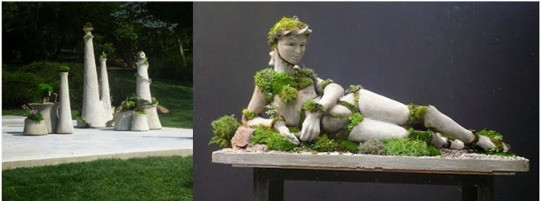
0 notes
Text
Discover Greenville: A Liberian Gem

Welcome to Greenville, a mesmerizing city in the heart of Liberia that beckons intrepid travelers with its rich culture, delectable gastronomy, and an array of thrilling activities. An urban silhouette nestled against a backdrop of pristine wilderness, Greenville is a vibrant blend of tradition and modernity. Whether you are an adventure enthusiast, a history buff, or a food lover, this captivating city has something to pique your interest.
When to Go
The best time to visit Greenville is during the dry season, which typically spans from November to April. During this period, the city experiences pleasant temperatures and lower rainfall, making it perfect for outdoor adventures. The city turns into a verdant landscape in the wet season from May to October; it is also a great time to visit if you love rain-caressed foliage.
How to Get There
Greenville is accessible by air via the Sinoe Airport, located just a short distance away from the city center. Several domestic airlines operate regular flights from Monrovia, the capital of Liberia, to Greenville. For a more scenic journey, consider a road trip from Monrovia, offering you pictures of stunning Liberian landscapes along the way.
Where to Stay
Whether you prefer luxurious hotels or cozy guesthouses, the city has a variety of accommodations to suit every traveler's preferences. For a truly immersive experience, consider staying at one of the locally-owned eco-resorts nestled amidst the lush wilderness, like the Eco Lodge Resort that offers chalets built in harmony with the surrounding environment, and provides an excellent service while promoting sustainable tourism practices.
What to Do
1. Immerse in the Rich Culture The bustling markets are the pulse of Greenville, displaying a vibrant array of traditional handicrafts and local delicacies, as well as providing an opportunity to interact with friendly locals who always welcome a conversation. The rhythm of traditional dance performances and music echoing around Greenville mirrors the indigenous heritage of Liberia. 2. Indulge in Gastronomic Delights Liberian cuisine is a fusion of West African and Caribbean flavors. The city's vibrant local eateries serve mouthwatering dishes like jollof rice, palm butter soup, and cassava leaf stew. A sip of the refreshing palm wine, a traditional Liberian beverage, completes the gastronomic journey. 3. Engage in Adventurous Activities For adventure seekers, Greenville offers activities like river safari along Sinoe River spotting exotic wildlife, hiking in the pristine Sapo National Park, and water sports along the Liberian coastline.
Sights and Tours
- Fortin de Saint Louis: Explore the historic French fort, a remnant of Greenville's colonial past. The fort offers stunning panoramic views of the city and provides insight into Liberia's captivating history. - Greenville National Museum: Delve into the city's heritage at this fascinating museum, housing a collection of artifacts and exhibits that shed light on Liberia's cultural evolution. - Kpatawee Waterfall: Nestled amidst lush greenery is the mesmerizing Kpatawee Waterfall. Its crystal-clear pools provide a refreshing spot for a dip, while its tranquil surroundings are perfect for a leisurely picnic.
Nightlife
Greenville offers a unique nightlife experience, with local bars and clubs playing rhythmic Liberian music such as highlife and reggae. The dance floors light up as the sun goes down, inviting everyone to join the celebration.
Transportation
Shared taxis are a convenient way to navigate Greenville's streets. For those who prefer a more leisurely pace, consider renting a bicycle and explore the city on your own.
Shopping
The city's vibrant markets offer locally made souvenirs, including carved wooden sculptures, vibrant textiles, and intricately woven baskets. The colourful stalls, the pleasant chatter of traders, and the unique pieces on offer make shopping in Greenville a unique experience. In conclusion, Greenville, Liberia's hidden gem, is a city waiting to be explored. From immersing in the vibrant culture to indulging in mouthwatering gastronomy and embarking on thrilling adventures, this city offers an exhilarating experience that will leave you with memories to cherish. So pack your bags, embrace your adventurous spirit, and get ready to unravel the enchanting mysteries of Greenville, Liberia. Read the full article
0 notes
Text

La dimensione antitetica della Fotografia.
Da un lato prendersi tempo, scattare con lenta ponderazione.
Dall'altro cogliere l'attimo, con ispirata tempestività.
Jure Kravanja mirabilmente contempera le due istanze.
Si direbbe:
comodo, meno difficile della pittura, la Fotografia.
Non si parte da una tabula rasa, si trova già tutto pronto.
Già, "pronto".
Il "pronto" alluderebbe ad una situazione ambientale, non temporale:
non si fabbrica, basta pigiare un bottone.
Già qui, prime concettuali pieghe.
Perché si sceglie sempre, in Fotografia, ciò che si trova.
E questo è già atto creativo.
Od almeno azione di linguaggio.
Poi c'è quell'altro "pronto", quello temporale.
Cogliere l'attimo e fissarlo, quelle risaputa cosa lì.
Jure riesce in ambedue.
Il primo "pronto", quello ambientale, trasfigura.
Sì, sublimando trasfigura.
Nel caso di Jure, rendendo deliziosamente astratto - per composizione di geometrie e colori - il fianco di una carrozza ferroviaria.
Sin qui, niente d'inedito:
il fotografo, scegliendo, interpreta, e - come scrivevo - questa operazione è già significante.
Poi c'è altro "pronto", quello, giustappunto, temporale.
Jure elevatamente fonde le due dimensioni.
La meditazione della contemplazione che si fa realizzazione.
E la capacità di cogliere un attimo - preveduto od impreveduto - e congelarlo.
Sì, la presenza umana dietro il fiestrino.
Così la Fotografia, quando l'esito è alto.
Far convergere forze, farle danzare sino alla fusione.
Per quanto essere primigeniamente appartengano a sistemi di pensiero gnoseologicamente distanti.
All rights reserved
Claudio Trezzani
0 notes
Text
Tailandia es un país de belleza asombrosa y cultura vibrante que cautiva a todos quienes lo visitan. Mientras que muchos conocen sus playas paradisíacas y su deliciosa comida, hay una gran cantidad de cosas que no sabías de Tailandia que hacen de este país un destino fascinante. En este artículo, exploraremos 21 datos interesantes que revelan la riqueza cultural, histórica y natural de Tailandia. 1. Tailandia es el Mayor Exportador de Arroz de Jazmín del Mundo Una de las cosas que no sabías de Tailandia es que es el mayor exportador de arroz de jazmín a nivel mundial. Este tipo de arroz es conocido por su aroma floral y sabor suave, y es un componente esencial de la cocina tailandesa. Su cultivo se concentra principalmente en la región del noreste de Tailandia. 2. El Rey Rama IX: Un Monarca Querido y Respetado El Rey Bhumibol Adulyadej, conocido como Rama IX, fue uno de los monarcas más queridos y respetados en la historia tailandesa. Su reinado, que duró más de 70 años, dejó una profunda huella en la nación. Su fallecimiento en 2016 fue un evento muy sentido en Tailandia, y su legado sigue presente en la vida cotidiana del país. 3. Tailandia Tiene el Festival de la Arena Más Grande del Mundo El Festival de la Arena de Pattaya, también conocido como el Pattaya International Sand Sculpture Festival, es uno de los cosas que no sabías de Tailandia. Este evento anual reúne a artistas de todo el mundo para crear impresionantes esculturas de arena en la playa de Pattaya, mostrando una impresionante gama de habilidades artísticas. Este año se llevó del 30 de abril al 19 de mayo, 20 días con exposiciones y eventos. 4. El Wat Arun es un Icono Arquitectónico de Bangkok El Wat Arun, también conocido como el Templo del Amanecer, es uno de los íconos más destacados de Bangkok. Este templo budista es famoso por su impresionante torre central, decorada con mosaicos de porcelana y con vistas panorámicas del río Chao Phraya. Es un lugar esencial para visitar y una de las cosas que no sabías de Tailandia. 5. La Isla de Phuket es Conocida por su Vida Nocturna Vibrante Phuket es una de las islas más conocidas de Tailandia, no solo por sus playas idílicas, sino también por su animada vida nocturna. Patong Beach, en particular, es famosa por sus bares, discotecas y entretenimiento nocturno, y es una de las cosas que no sabías de Tailandia que atrae a los visitantes en busca de diversión. https://www.destinoasiaviajes-travel.com/tour/offerta-viaje-a-tailandia/ 6. Tailandia es el País del “Sonrisa Eterna” Uno de los apodos más conocidos de Tailandia es el “País de la Sonrisa”. Este nombre refleja la amabilidad y hospitalidad de su gente. Los tailandeses son conocidos por su actitud amigable y su disposición a ayudar a los visitantes, haciendo de cada experiencia en el país una más cálida y acogedora. 7. El Mercado Flotante de Damnoen Saduak: Un Atractivo Único El mercado flotante de Damnoen Saduak, ubicado cerca de Bangkok, es una de las cosas que no sabías de Tailandia que ofrece una experiencia de compra única. Los vendedores venden productos frescos y comidas tradicionales desde embarcaciones, ofreciendo una inmersión en la vida local y la cultura tailandesa. 8. Tailandia es el Hogar de Más de 1,000 Templos Budistas Con más de 1,000 templos budistas, Tailandia es un país donde el budismo juega un papel central en la vida diaria. Cada templo, conocido como "wat", tiene su propia historia y arquitectura distintiva. Estos templos no solo son lugares de culto, sino también importantes destinos turísticos. 9. La Comida Tailandesa es Reconocida a Nivel Mundial La cocina tailandesa es famosa en todo el mundo por sus sabores vibrantes y su equilibrio de ingredientes. Platos como el pad thai, el tom yum y el curry tailandés son internacionalmente conocidos. La combinación de dulzura, acidez, salinidad y picante hace que la comida tailandesa sea una experiencia culinaria inolvidable. 10. La Danza del Máscara de Khon es una Tradición Cultural La danza del
Khon es una forma tradicional de teatro tailandés que combina danza, música y máscaras elaboradas para representar historias épicas del Ramayana. Esta forma de arte es una de las cosas que no sabías de Tailandia que destaca la riqueza cultural y las tradiciones del país. 11. Tailandia es el Destino de Más de 35 Millones de Turistas al Año Tailandia recibe más de 35 millones de turistas al año, lo que lo convierte en uno de los destinos turísticos más populares del mundo. Esta afluencia de visitantes es testimonio de la belleza del país y su atractivo para aquellos que buscan explorar sus playas, ciudades y cultura. 12. El Elephant Nature Park es un Refugio para Elefantes Rescatados El Elephant Nature Park, ubicado en Chiang Mai, es uno de los cosas que no sabías de Tailandia. Este santuario ofrece un hogar seguro a elefantes rescatados de situaciones de abuso y explotación. Los visitantes pueden aprender sobre la conservación de los elefantes y contribuir al bienestar de estos majestuosos animales. 13. Tailandia Tiene Más de 1,400 Islas y Archipiélagos Con una costa extensa, Tailandia cuenta con más de 1,400 islas y archipiélagos, muchas de las cuales son destinos turísticos populares. Islas como Koh Samui, Koh Phi Phi y Koh Lanta ofrecen playas paradisíacas, aguas cristalinas y oportunidades para actividades acuáticas. https://www.destinoasiaviajes-travel.com/tour/explora-tailandia-phuket/ 14. El Songkran es el Festival de Agua Más Grande del Mundo El Songkran, el Año Nuevo tailandés, es famoso por sus festividades con batallas de agua en las calles. Esta celebración, que tiene lugar en abril, es una de las cosas que no sabías de Tailandia, y permite a los locales y visitantes disfrutar de una fiesta refrescante y llena de diversión. 15. La Piedra de Tiger Cave Temple es una Maravilla Natural El Tiger Cave Temple, ubicado en Krabi, es conocido por su impresionante escalinata que lleva a una plataforma de observación con vistas panorámicas. Una de las cosas que no sabías de Tailandia es que esta montaña, también conocida como Wat Tham Sua, es famosa por las huellas de tigre que se encuentran en la cueva. 16. El Sistema de Transporte en Tailandia es Variado y Eficiente Desde tuk-tuks hasta barcos de cola larga y el Skytrain en Bangkok, el sistema de transporte en Tailandia es diverso y eficiente. Esta variedad de opciones de transporte es una de las cosas que no sabías de Tailandia que facilita a los visitantes moverse por el país con comodidad. 17. La Isla de Ko Chang es el Refugio Perfecto para los Amantes de la Naturaleza Ko Chang es una isla en el golfo de Tailandia conocida por su belleza natural y su ambiente relajado. Con cascadas, selvas y playas tranquilas, esta isla es uno de los secretos mejor guardados del país, una de las cosas que no sabías de Tailandia para quienes buscan un escape de la vida urbana. 18. La Arquitectura de los Templos Tailandeses es Única Los templos tailandeses son conocidos por su arquitectura distintiva, que incluye techos en ángulo hacia arriba, coloridos mosaicos y detalles ornamentales. Cada templo, desde el Gran Palacio en Bangkok hasta el Wat Pho, exhibe una belleza arquitectónica que es una de las cosas que no sabías de Tailandia. https://www.destinoasiaviajes-travel.com/tour/itinerario-completo-asiatico/ 19. El Mercado de Chatuchak es un Paraíso para los Compradores El mercado de Chatuchak en Bangkok, también conocido como el mercado de fin de semana, es uno de los mercados más grandes del mundo. Con más de 15,000 puestos que venden de todo, desde ropa hasta comida y antigüedades, es una de las cosas que no sabías de Tailandia y un lugar imperdible para los amantes de las compras. 20. Tailandia es la Cuna de los Muay Thai El Muay Thai, o boxeo tailandés, es un arte marcial que se originó en Tailandia y es conocido por sus técnicas de golpeo con codos, rodillas y pies. Este deporte, una de las cosas que no sabías de Tailandia, es un aspecto importante de la cultura tailandesa y se practica tanto a nivel profesional como amateur.
21. El Parque Nacional Khao Sok es un Tesoro Natural El Parque Nacional Khao Sok, en el sur de Tailandia, es hogar de uno de los bosques lluviosos más antiguos del mundo. Con su impresionante lago Cheow Lan, cascadas y vida silvestre, es uno de los cosas que no sabías de Tailandia que ofrece una experiencia inolvidable para los amantes de la naturaleza y los aventureros. Explora Tailandia fabuloso grandioso: Bangkok, Chiang Rai, Chiang Mai, Krabi, Koh Phi Phi, Phuket ¡Todo incluido en 16 dias! Para más contenido como este no te olvides de visitar nuestras redes sociales: Facebook Instagram Youtube
0 notes